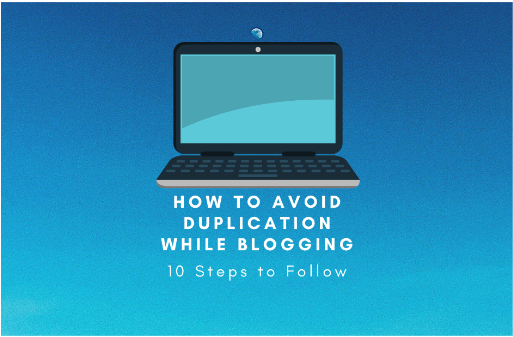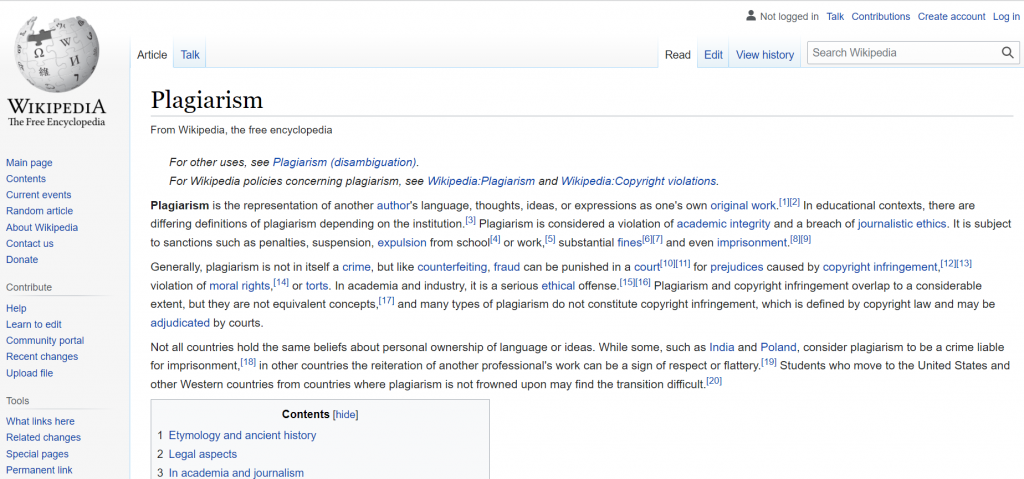How to Avoid Duplicate Content While Blogging (10 Steps to Follow)
Learning how to avoid duplicate content while blogging can be difficult for many writers.
While duplicate content can be harmful to all types of writing (regardless of its nature), it can be particularly detrimental to blog posts and website content. One way to be a successful writer and blogger is to master how to avoid duplicate content while blogging.
According to a study conducted by Raven Tools, you can find plagiarized and duplicated content on 29% of websites on the internet.
Search engines flag copied content, and penalize the perpetrating website. These penalties can range from a rank drop for a particular keyword to a complete website delisting.
In other words, plagiarized and duplicated content can completely take your website out of the running and waste all your SEO efforts. And apart from the technical repercussions that you’ll get from the search engine, you will also irreparably damage your reputation and integrity as a writer.
There are a lot of different measures that you can take to make sure that all the content on your blog is unique and original. In this post, we are going to be looking at 10 such steps that you can easily incorporate into your content creation process.
What is Plagiarism?
Before we get to discuss the steps, let’s take a quick look at what plagiarism is, as well as some of its well-known types.
Plagiarism, in the context of writing, can be roughly defined as the act of taking someone else’s content and using it in one’s work without giving the original author the due credit.
Among others, these are three of the most common forms in which plagiarism can occur:
- Direct Plagiarism
- Mosaic Plagiarism
- Source-Based Plagiarism
- Direct plagiarism occurs when a person copies and pastes content from an existing source without making any changes to it and without citing the original author. This is the most flagrant and glaring type of plagiarism, and it is very easy to spot.
- Mosaic plagiarism is slightly less overt than direct plagiarism. In this type of plagiarism, the copied text is mixed with some original text. The result is a blend of duplicated and unique content.
- Source-based plagiarism, on the other hand, occurs when a writer fails to properly cite the source that they have quoted or taken their information from.
10 Steps on How to Avoid Duplicate Content While Blogging
Use Multiple Sources for Research
If you have been in the writing business for some time, you’ll know that plagiarism can, in most cases, come into your writing even if you don’t have the slight intention or idea of doing it.
This is called accidental plagiarism, and this is an issue faced frequently by straight and honest writers.
Using multiple sources for research is a great way to make sure that you don’t get this type of plagiarism in your writing. If you use a single source to get all your information, you can unintentionally start to mimic and imitate their phrases, words, writing style, and ideas.
By spreading your research out on multiple publications and platforms, you can mix and match the information and come up with a unique outline for your blog post. This way, you’ll avoid duplicate content while blogging and unknowingly copying the writing style of a particular source.
Don’t Copy Title Ideas
Not copying title ideas from popular posts can also be a great way to avoid getting duplicated content on your blog.
If you happen to take the titles from previously published posts and articles on the internet, there are a lot of chances that you could write about the same things using the same type of terminology.
Apart from amounting to accidental plagiarism, this type of title stealing can also be harmful to your blog readership.
The first thing that the reader is going to see when they visit your blog is the title of the post. If you have nicked the title from a popular front-page website, the user is going to recognize it easily.
Title copying may sound and seem innocent enough, but it can go a long way to hurt your integrity and reputation as a writer.
According to Envisagedigital.co.uk, approximately 4.4 million blog posts are published daily across all the blogging platforms. Considering this, it can seem daunting to come up with a new and unexplored title.
But it’s not. You can take some help from idea generating software or just do some brainstorming, and you’ll have a unique title easily enough.
Don’t Copy-Paste Content Directly
While writing blog posts, there can arise different situations where you may need to take someone else’s words and use them in your content.
However, there are some clean and legitimate ways of going about this (more of which we will discuss further on in this post).
For one, you can simply take the content and change its sentence structure. Mind you, paraphrasing is something different and we’re not discussing that right now.
By simply changing the sentence layout and arrangement, you can prevent it from being recognized as plagiarism. However, you should still clearly mention the name of the source.
For example, this is a sentence taken from Wikipedia:
“Plagiarism is the representation of another author’s language, thoughts, ideas, or expressions as one’s own original work.”
If you were to take this sentence and paste it into your content as it is, it would get recognized as plagiarism.
However, if you were to alter the sentence structure and change it into something like this:
“The representation of another author’s thoughts, language, expressions, or ideas as one’s own original work is known as plagiarism.”
…then it will cease to be plagiarism. It should be noted that this does not fall within the category of paraphrasing as it does not involve altering the words and phrases of the text.
However, it has to be stressed that this should only be done where it becomes inevitable to borrow content from a source. The original source should also be necessarily mentioned.
Use Quotes
The method mentioned above can be used if the material that you want to copy can be subjected to changes and edits.
However, in situations where you need to take the exact words from a source, you’ll have to use quotation marks.
Whenever a writer wraps a sentence or paragraph in quotation marks, it is taken as an automatic indication that the particular content is not their own.
While it is fine to only put the (“”) marks around the copied text, it is better to style it in italics as well. That way, it becomes more noticeable…for example:
“This is just some sample text.”
Develop Your Own Style
As we mentioned in the first step of this list, you should spread out your research on multiple sources so that you don’t accidentally start mimicking the style of a particular one.
But, merely avoiding someone else’s writing style is not enough. You must develop your own MO so that there is no danger of accidentally copying someone else.
When it comes to writing styles, things like transition words, bucket-brigade terms, and crutch phrases make them all different. You should try to come up with your own openers and conclusion phrases rather than resorting to clichés.
Use Hyperlinks
Hyperlinks can be useful in situations where you want to cite a source without mentioning its exact name. You can add a hyperlink to a general term or phrase.
For example, you can just write ‘According to so-and-so research’ and then add a hyperlink to the word ‘research’. Similarly, you can write ‘As per this study’ and then hyperlink the word ‘study’.
Another benefit of adding hyperlinks is that they help to improve the SEO of your website. We won’t go into a lot of details about that aspect.
We’re just mentioning it here because, after all, we are talking to bloggers.
A useful tip mentioned by Problogger was to add a hyperlink before ‘the fold’. The ‘fold’ refers to the part of the webpage where the readers have to scroll down.
According to Problogger, online users spend 80% of their time looking at information and data given ‘before the fold’.
Use Plagiarism Checkers
Even after you take all the necessary steps for avoiding plagiarism in your writing, it can still sneak in some way or the other. To detect and eliminate this type of inevitable plagiarism, you can take the help of a free plagiarism checker.
For bloggers, it is recommended to always run their content through a duplication checker before finalizing it.
This holds particular application for those bloggers who work with popular niches. The more popular a niche is, the more content will be found on the internet related to it.
If you have the time, you should even try to run the finished content through multiple plagiarism checkers rather than just one.
Experts recommend this because the algorithms used by various tools can differ. There could be some plagiarism in your content that could be getting past a particular tool, but it may get caught by another one.
Add Citations and References
People usually use citations and references in academic writing, but you can use them in other types of content as well.
Citations and references are, contrary to what many people may think, two different things.
The ‘citation’ is the bracketed text that is found within the content, and it usually features the name of the author as well as the year of the particular publication e.g., (Johnson, 2011).
References, on the other hand, is a detailed account of the source that contains everything from the name of the author, their institution, the name of the journal/book, and the date of publication. References are collectively mentioned at the end of the content.
This is what references generally look like:
Doe, J., 2022. Sample Citation. [online] sample.com. Available at: <https://www.sample.com/> [Accessed 11 May 2022].
Do Proper Paraphrasing
Paraphrasing is the process of replacing specific words and phrases in a piece of content to make it unique and different while retaining the original meaning and context.
For example, this sentence…
“He walked to the bridge to throw the box in the river.”
…can be paraphrased to look like this:
“He went to the bridge to toss the container in the water.”
The meaning and context of both sentences are more or less identical. However, since the wording is different, they won’t be recognized as duplicated copies.
You may have noticed that the name of this heading is ‘Do Proper Paraphrasing’. The reason behind the emphasis on ‘proper’ is that paraphrasing can also be done haphazardly and carelessly.
When paraphrasing is done improperly, the resultant text clearly and visibly looks like a copied job.
This can happen when only a few words of the text are replaced, and no actual effort is made to make it look unique.
For proper paraphrasing, you can either take the help of an online paraphrasing tool or you can do it manually.
Add Footnotes
Footnotes can serve the same function as citations and references.
If you don’t want to use in-text citations and references in your content, you can simply add a number in superscript (like this “[1]”) and then add a footnote corresponding to the number at the footer of the page.
For example, you could add a footnote indicator after some borrowed text in your content, and then you could mention the details of the source in the footnote.
In blog posts and online articles, the footnotes are written after the conclusion since there are no defined pages.
Conclusion on How to Avoid Duplicate Content While Blogging
Duplicated content can be very harmful to your blog. It can get your website hit by a search engine penalty, and it can have a negative effect on your readership.
In this post, we discussed 10 different steps to help you avoid duplicate content while blogging and ensure that your blog content is completely free from plagiarism.
If you ever need to take some material directly from a source, be sure to use quotation marks, citations and references, footnotes, or hyperlinks to credit the original author.
One thing that you should remember is that even after taking the proper steps during the research and writing phase, some bits of plagiarism can still appear in your content. Hence, it is essential to use a plagiarism-checking tool before finalizing any type of post, article, or description that you want to upload to your blog.





